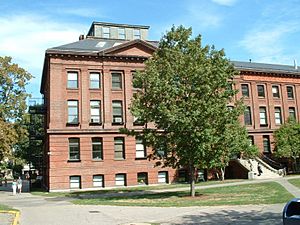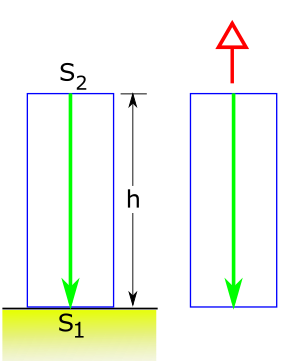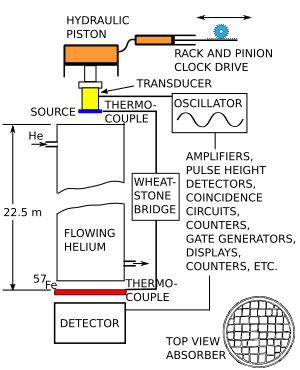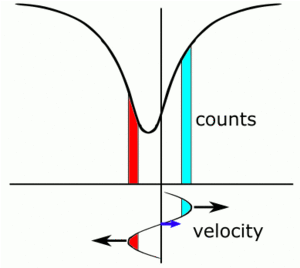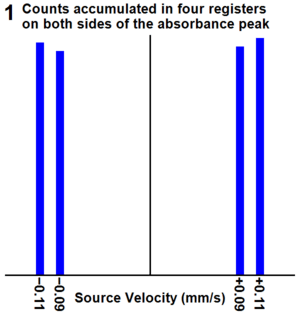Pound–Rebka experiment facts for kids
The Pound–Rebka experiment was a famous science test done in 1960. It looked at how gamma rays (a type of light) changed as they moved up and down in Earth's gravity. This experiment helped prove Einstein's ideas from 1907 and 1911. He predicted that light would gain energy when falling in gravity and lose energy when rising.
Scientists Robert Pound and his student Glen A. Rebka Jr. proposed this test in 1959. It was the last of the main classical tests of general relativity to be confirmed. The experiment showed that gravity affects the frequency of light. This means that clocks would seem to run at different speeds in different parts of a gravitational field. This experiment was very important for starting an age of super-accurate tests of Einstein's theory.
Contents
Understanding Gravity and Light
Einstein's Idea: Gravity Changes Light
Before Einstein finished his full theory of general relativity, he had some early ideas. One of these was about how gravity affects light. He thought that light would change its "color" or frequency when moving through a gravitational field.
Imagine a light source at the top of a tall building and a receiver at the bottom. The light travels from the top to the bottom. Einstein's idea, based on the equivalence principle, said this is like the receiver speeding up as the light comes towards it. Because the receiver is speeding up, the light waves would seem to get squished together. This makes the light's frequency higher, like a Doppler effect for sound.
So, light falling in gravity gains energy and its frequency increases (a "blueshift"). If light rises against gravity, it loses energy and its frequency decreases (a "redshift").
General Relativity and Early Tests
In 1916, Einstein used his new theory of general relativity to explain these ideas more deeply. Gravitational redshift was one of three main predictions from his theory. The others were about how Mercury's orbit shifts and how the Sun bends light.
The bending of light by the Sun was proven in 1919. This made Einstein very famous. But proving gravitational redshift was much harder. The predicted change in light was tiny, only two parts in a million for light from the Sun. Other things like temperature and pressure on the Sun could easily hide this small effect. Early attempts to measure it were not clear.
In 1925, W.S. Adams claimed to have measured it from the star Sirius B. However, even his measurements were later questioned. Scientists needed a much more precise way to test this idea.
The Mössbauer Effect: A New Tool
In 1958, a scientist named Rudolf Mössbauer made an important discovery. He found a way to make gamma rays (a type of high-energy light) hit a target without losing energy. Normally, when an atom shoots out a gamma ray, the atom itself recoils, like a gun kicking back. This recoil takes away some energy from the gamma ray.
Mössbauer found that if he cooled the material very cold, the atoms would not recoil as much. This meant the gamma rays kept their exact energy. This "recoilless gamma-emission" was called the Mössbauer effect. It allowed for incredibly precise measurements of gamma ray energy.
In 1959, several research teams realized this new effect could be used to finally test gravitational redshift on Earth. The most famous teams were Robert Pound and Glen Rebka at Harvard, and another team in England.
In February 1960, the English team announced they had measured gravitational redshift. But their measurement had a large error. Pound and Rebka's experiment, finished in April 1960, used a stronger source and a longer path. They also made many improvements to reduce errors. Their results were accepted as the definite proof of gravitational redshift.
Pound and Rebka's Experiment
Challenges and Solutions
Pound and Rebka chose to use a special type of iron, called 57Fe, for their experiment. It was good because it didn't need to be super cold to work. It also didn't produce other confusing radiation.
They found that small changes in temperature were a big problem. Even a 1°C difference between the top and bottom of their setup could mess up the results. This was because temperature affects how atoms vibrate, which changes the gamma ray's energy slightly. They also found that the exact chemical makeup of their iron samples could cause small energy shifts.
To fix these issues, they had to be very careful. They measured temperatures precisely and prepared their samples with extreme care.
How the Experiment Was Set Up
The experiment took place in a tall tower at Harvard University. This tower was specially built to avoid vibrations from the rest of the building.
- Source: At the top of the tower, they placed a small piece of iron with radioactive 57Co. This produced the gamma rays. It was also attached to a special speaker coil that could move it up and down very slightly.
- Absorber: In the basement, 22.5 meters (74 feet) below, they placed a large sheet of iron enriched with 57Fe. This sheet was designed to absorb the gamma rays.
- Path: The gamma rays traveled through a plastic bag filled with helium gas. This stopped the rays from scattering too much.
- Detector: Below the absorber, a special counter detected the gamma rays that passed through.
The speaker coil at the top made the gamma ray source vibrate. This created a small, controlled Doppler effect on the gamma rays. They also slowly moved the source up and down using a hydraulic system. Every few days, they would switch the source and absorber. This way, they could measure both gamma rays rising (redshift) and falling (blueshift).
They used three thermometers on the source and three on the absorber to measure temperature differences. These readings helped them correct their data. They also tried different vibration speeds and equipment to make sure their results were accurate.
Detecting Tiny Shifts
The gamma rays from 57Fe have a very precise energy. But the change in energy due to gravity was incredibly small. It was 500 times smaller than the natural "width" of the gamma ray's energy.
To find such a tiny change, they used a clever method called "slope detection." Instead of trying to measure the exact peak of the gamma ray's energy, they measured it on the "slopes" of the energy curve. This is like trying to find a tiny bump on a hill by looking at how steep the sides are, rather than trying to measure the exact height of the very top.
The vibrating speaker coil and the slow hydraulic motion worked together. They collected gamma rays in four different "channels" based on the source's movement. This allowed them to precisely figure out the exact energy of the gamma rays after they traveled through the tower.
They collected a huge number of gamma rays, about 10 billion! This large amount of data, combined with their careful methods, allowed them to measure the tiny gravitational effect.
Results of the Experiment
Pound and Rebka collected data for many days. They swapped the source and absorber often. This helped them remove any fixed differences between their equipment.
In their 1960 paper, they showed their first results. After correcting for temperature, they found a small but clear change in the gamma ray frequency due to gravity. Their final measurement showed a frequency shift of about -2.56 parts per quadrillion (a very tiny number!). This was very close to Einstein's predicted value, with an error of only 10%.
Over the next few years, Pound's lab improved their measurements even more. By 1964, they had confirmed the gravitational redshift with an accuracy of 1%.
Gravity's Effect Today
After the Pound-Rebka experiment, other tests using different technologies also proved gravitational redshift. A famous example was the 1976 Gravity Probe A experiment. It used a super-accurate clock in space to measure the effect even more precisely, with an accuracy of about 0.01%.
Today, gravitational redshift is not just a theory. It's a practical part of engineering. For example, the Global Positioning System (GPS) relies on Einstein's theory of relativity to work correctly. Without accounting for gravitational time changes, GPS would be wrong by many kilometers each day!
From a science point of view, general relativity is still our best theory of gravity. But scientists know it's not the final answer. They are always looking for ways to test it even more precisely.
The idea that clocks run at different rates in different places in a gravitational field is called "Local Position Invariance" (LPI). Gravitational redshift measurements directly test LPI. Scientists are still trying to measure LPI with even greater accuracy. For example, the European Space Agency's Atomic Clock Ensemble in Space (ACES) mission hopes to improve on past measurements by 35 times!
See also
 In Spanish: Experimento de Pound y Rebka para niños
In Spanish: Experimento de Pound y Rebka para niños


